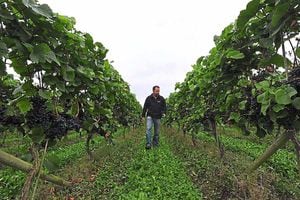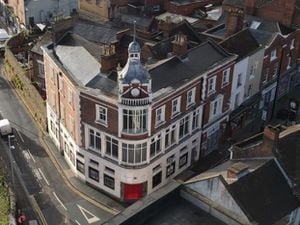Shropshire and Mid Wales: A grape place to produce wine
It used to be considered a novelty, but British wine is on the up – and vineyards in Shropshire and Mid Wales are among those toasting the industry's success.

Sales of home-grown wine are booming across the region with increases of more than a fifth as consumers realise the quality of local vineyards and choose to buy British.
Sales of English and British wine at Waitrose have increased by 22 per cent at the start of this year on top of an 80 per cent year-on-year rise that was reported in December, making it the retailer's fastest growing drinks range.
That is great news for Halfpenny Green Vineyards near Bridgnorth, where marketing assistant Ben Godbehere said demand is on the up and up.
"We are seeing a 20 per cent rise in sales, so that figure sounds about right," he said.
"Over the past few years, we have seen a huge rise in sales of our wine, particularly our most popular wine, a sparkling rose, which costs about £19.95.
"I think consumers have come to appreciate how great our wine is now, in comparison to foreign wines including champagne in France and Prosecco in Italy.
"We are keeping a particular eye on the rise in popularity of Prosecco, which is a sweet wine.
"I think an element of the rise in popularity of UK wines is down to the warmer summer temperatures we have been having in the UK in recent years, combined with our up-to-date technology here."
Waitrose has recognised the quality of wines at Halfpenny Green, in Bobbington.
It will soon start selling its Halfpenny Green Tom Hill 2014 in our region's stores and online, as well as in its John Lewis Food Hall on Oxford Street.
Head winemaker Clive Vickers said: "Our Long Acre 2014 dry white has featured in local M&S stores and online exclusively for the past year, and in addition, our Rose Sparkling 2013 and Mercia 2014 have just been added to the range.
"After our best ever year in 2014 and over 20 national and international awards, we're delighted that Waitrose and Marks and Spencer have taken on our wines. They see the public's growing love of English wine and are rightly reaping the rewards."
Ben explained the UK couldn't yet compete on price with most foreign wines because they produce their wine in larger quantities which reduces the ongoing costs.
But he said an increasing amount of people are buying crates of local wines for weddings and special occasions because it is a great talking point.
"We are smaller producers here in England but we can produce award-winning wine," he said.
"We find that our customers like the fact that we are producing our wines, including Mercia 2014, Tom Hill 2014, on site. Our wines are grown, matured and sold within a space of just 200 metres and that's what people tend to like these days."
Ben said 2014 was a particularly good year for British wines and he is hoping that 2016 will be a successful year too.
"At the start of each year we hope for a good summer, with lots of warm sun, good sugar levels in the grapes and a big harvest.
"In 2014 we produced a 15 per cent alcohol volume red - a Rondo - we don't usually make it here this far northwards, it is usually made by countries in line with Italy."
Ben said springtime is a time of preparation in the British wine world.
"At the moment we are taking care of the vines on our 30-acre vineyard, making sure they are not affected by the frost before the vines start budding and flowering," he said.
"We expect grapes to appear in early summer and then hope for another good harvest - but a lot of it depends on the levels of sunshine."
Penarth Vineyard at Pool Road, Newtown, in Mid Wales have also seen an increase in wine sales, particularly their sparkling wines and their Chardonnay, which has a gooseberry finish.
The growing popularity of English wine has been helped by a renaissance in English food. Chefs want local wine to go with their locally sourced food, and English wine is now on the menus of high-end restaurants owned by Gordon Ramsay, Heston Blumenthal and Jamie Oliver.
This in turn has fuelled a rush to develop UK vineyards, with applications rising by more than 40 per cent over the past couple of years.
Miles Beale, chief executive of the Wine and Spirit Trade Association, said the production of English wine has seen record vintages with 4.5m bottles in 2013 and 6.3m bottles in 2014. Based on the latest growth figures, this is set to double, with a staggering 12m bottles of English wine per year expected by 2020."
Though the British wine industry appears to be booming as the effects of climate change become more apparent, and the government has recently announced its support for growing production, new research suggests that the future may not be quite so rosé for British wines, as cold snaps, sharp frosts and downpours still threaten productivity.
UK wine producers hope 2016 will be a bumper season, but research from the University of East Anglia suggests year-to-year climate variability and hazardous weather at key points in the growing season - arising as a result of climate change - are likely to leave the industry highly sensitive to the elements.
The research also suggests that in vogue varieties such as Chardonnay and Pinot Noir are more susceptible to UK climate variability than traditional varieties.
Over the last decade, the amount of land used for viticulture has increased by 148 per cent - with around 1884 hectares currently under vines. Last month, after a meeting between Defra officials and wine industry representatives, Environment Secretary Liz Truss announced plans to grow Britain's wine industry. The meeting ended in an agreement to double wine production in Britain by 2020.





